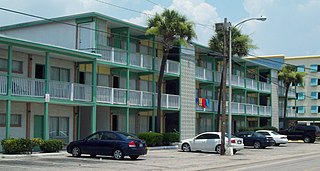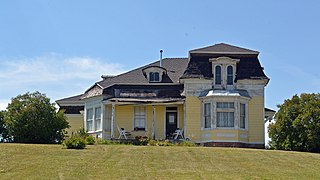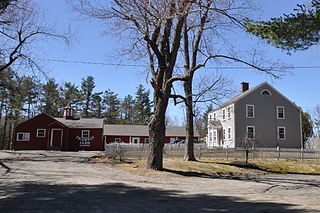
A motel, also known as a motor hotel, motor inn or motor lodge, is a hotel designed for motorists, usually having each room entered directly from the parking area for motor vehicles rather than through a central lobby. Entering dictionaries after World War II, the word motel, coined as a portmanteau of "motor hotel", originates from the Milestone Mo-Tel of San Luis Obispo, California, which was built in 1925. The term referred to a type of hotel consisting of a single building of connected rooms whose doors faced a parking lot and in some circumstances, a common area or a series of small cabins with common parking. Motels are often individually owned, though motel chains do exist.

Glenrio, formerly Rock Island, is an unincorporated community in both Deaf Smith County, Texas, and Quay County, New Mexico, United States. Located on the former U.S. Route 66, the ghost town sits on the Texas–New Mexico state line. It includes the Glenrio Historic District, which was listed on the National Register of Historic Places in 2007.

The Wigwam Motels, also known as the "Wigwam Villages," is a motel chain in the United States built during the 1930s and 1940s. The rooms are built in the form of tipis, mistakenly referred to as wigwams. It originally had seven different locations: two locations in Kentucky and one each in Alabama, Florida, Arizona, Louisiana, and California.

The Santanoni Preserve was once a private estate of approximately 13,000 acres (53 km²) in the Adirondack Mountains, and now is the property of the State of New York, at Newcomb, New York.

Munson Valley Historic District is the headquarters and main support area for Crater Lake National Park in southern Oregon. The National Park Service chose Munson Valley for the park headquarters because of its central location within the park. Because of the unique rustic architecture of the Munson Valley buildings and the surrounding park landscape, the area was listed as a historic district on the National Register of Historic Places (NRHP) in 1988. The district has eighteen contributing buildings, including the Crater Lake Superintendent's Residence which is a U.S. National Historic Landmark and separately listed on the NRHP. The district's NRHP listing was decreased in area in 1997.

There are nine historic districts in Meridian, Mississippi. Each of these districts is listed on the National Register of Historic Places. One district, Meridian Downtown Historic District, is a combination of two older districts, Meridian Urban Center Historic District and Union Station Historic District. Many architectural styles are present in the districts, most from the late 19th century and early 20th century, including Queen Anne, Colonial Revival, Italianate, Art Deco, Late Victorian, and Bungalow.
J. Foster Warner (1859–1937), also known as John Foster Warner, was a Rochester, New York-based architect. He was the son of one of Rochester's most prominent 19th century architects, Andrew Jackson Warner (1833-1910). After receiving his architectural training in his father's office, the younger Warner opened his own office in 1889 and remained in continuous practice until his death in 1937.

Rainbow Court was a historic hotel complex located at Myrtle Beach in Horry County, South Carolina. The complex of buildings ranged in dates of construction from 1935 to 1959. The complex included: two motel-type buildings, five beach cottages/boarding houses, and a small house. The buildings were situated around an open court with a swimming pool. There were six contributing buildings. It was one of the few remaining examples of the small-scale, low-rise motels that pre-dated Hurricane Hazel (1954).

The Boots Motel, a historic U.S. Route 66 motor hotel in Carthage, Missouri, opened in 1939 as the Boots Court at 107 S. Garrison Avenue.
The Atlanta Ranger Station, also known as Atlanta Guard Station, is a 24 acres (9.7 ha) historic district in Boise National Forest in Atlanta, Idaho that was listed on the National Register of Historic Places in 2003. It includes 10 contributing buildings dating as far back as 1933. The complex was built by the Civilian Conservation Corps and designed by the USDA Forest Service, and includes Forest Service R-4 Standard and other architecture. The listing included ten contributing buildings.

The Wagon Wheel Motel, Café and Station in Cuba, Missouri, is a 19-room independently owned historic U.S. Route 66 restored motel which has been serving travelers since 1938. The site opened as a café in 1936; the motel has remained in continuous operation since 1938. The motel rooms were fully restored in 2010, adding modern amenities such as HDTV and wireless Internet.

The Williams Deluxe Cabins are part of an historic motel complex that is located in West Whiteland Township, Chester County, Pennsylvania.
Bald Mountain Hot Springs in Ketchum, Idaho was a historic resort. Located at Main and 1st St. in Ketchum, the complex was listed on the National Register of Historic Places in 1982. In 2003, plans had been approved for a new 80-room hotel complex on the site.

The Alfred Budge House, in Paris, Idaho, located at N. 1st, West at W. 1st, North, is a historic house that was built in 1880. It was renovated to include Second Empire styling, including a mansard roof, at a later date. The house has a complex design with three major sections and multiple smaller ones; while the mansard roof tops the main section, the house has eight roof components in total. It is listed on the U.S. National Register of Historic Places; the listing included six contributing buildings.

The W.E. Barnard House, at 950 Joaquin Miller Dr. in Reno, Nevada, United States, was built in 1930. It includes Tudor Revival architecture, and, within that, is best described as a Cotswold Cottage style small house. Its two most dominant architectural features are a beehive chimney and a "high-pitched, gabled entry with a characteristic Tudor arch".

The Asa Morse Farm, also known as the Friendly Farm, is a historic farmstead on New Hampshire Route 101 in Dublin, New Hampshire. The main farmhouse, built in 1926 on the foundations of an early 19th-century house, is a good example of Colonial Revival architecture, built during Dublin's heyday as a summer retreat. The farmstead was listed on the National Register of Historic Places in 1983.

The Web Long House and Motel is a historic former motel complex on the north side of United States Route 63, just east of Springwood Road, on the outskirts of Hardy, Arkansas. The complex includes three buildings: a single-story stone house, which also served as the office for the motel, a duplex located just to its east, also built of flagstone, and a four-unit stone motel building facing south. The complex was built in 1943 by Web Long, president of the Hardy Development Council, as a home for his family and a business serving travelers. It is one of the earliest known examples of motel architecture in Sharp County.

The Colonial Inn is a historic hotel at 145 Shore Road in Ogunquit, Maine. The hotel complex is anchored by an 1890 Queen Anne Victorian hotel that is one of the few surviving resort hotels of the period, and is listed on the National Register of Historic Places. The complex also has rooms in adjacent motel spaces; its amenities include a swimming pool, game room, and dining room serving breakfast.

The Cottage Courts Historic District encompasses a historic travelers' accommodation at 609 Park Avenue in Hot Springs, Arkansas. Built about 1950, it was one of the first motel-type tourist accommodations to be built in the city. Unlike earlier tourist courts, which typically had idiosyncratic vernacular architecture, Cottage Courts consists of two ranch-style single-story buildings, one of which houses twelve guest rooms, and the other three plus the operator's apartment and office.

The 66 Motel in Tulsa, Oklahoma was built on the original, two-lane U.S. Route 66 around 1933 and was listed on the National Register of Historic Places in 1996. The listing included two buildings: the main or office building and a separate strip of motel rooms. The buildings are described as having "a vernacular interpretation of the Moderne style of architecture, sharing similar characteristics such as horizontal emphasis, flat roofs, asymmetrical design, and glass block windows."



















